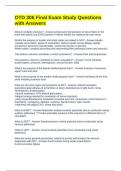OTD 306 Final Exam Study Questions
with Answers
What is multiple sclerosis? - Answer-progressive demylination of nerve fibers in the
brain and spinal cord (CNS) portion of myelin sheath are replaced by scar tissue
What's the purpose of myelin and white matter as related to MS? - Answer-Myelin:
insulate nerve fibers, speed of conduction, without myelin nerves fatigue rapidly
(conduction becomes unpredictable, varies from person to person)
White matter: contains ascending and descending fiber pathways (motor and sensory)
The anterior columns contribute to which sensations? - Answer-Pain and temperature
The posterior columns contribute to which sensations? - Answer-Touch vibration,
propioception, pressure, stereognosis, sexual function, B&B
What's the purpose of the lateral vestibulospinal tract? - Answer-Extensor movement,
upper trunk and neck
What is the purpose of the medial vestibulospinal tract? - Answer-facilitates flexor tone
while inhibiting extensor tone
What are the early signs and symptoms of MS? - Answer--Altered sensation
(paresthesia/dyesthesia of extremities or face), disturbances in light touch, temp,
stereognosis, propioception,
-muscle weakness- 87% altered gait pattern,
-fatigue (energy needed for conduction of nerve impulses),
-early visual disturbances (impaired horizontal eye m/m, oculomotor control lesions in
brainstem), nystagmus, diplopia, scotoma, blurred vision, optic neuritis
-trigeminal neuralgia (CN 5, sharp face pain)
What is BAEP? - Answer-Brainstem auditory evoked potentials (nerve conduction along
auditory pathways) ****evoke potentials measure CNS response to different forms of
stimulation
What is SEP? - Answer-Somatosensory evoked potential (nerve conduction along
sensory pathways)
What is VEP? - Answer-Visual evoked potential (nerve conduction long visual
pathways)
What are some general precautions related to activity performance for persons
diagnosed with MS? - Answer-Avoid activity during acute exacerbation
Avoid excessive fatigue
,No heavy resistance or strenuous activity
Avoid excessive heat and humidity
Cooling vest
What is ALS? - Answer-Muscle atrophy caused by degeneration of the anterior horn
cells
Why do the anterior horn cells contribute to ALS? - Answer-motor nuclei of brain stem
What are the UMN symptoms of ALS? - Answer-stages III-VI
Spastic paralysis
hyper reflexia
Babinski may be positive
No effect on eye function, cognition, B&B because these pathways travel through the
posterior portion of the spinal cord
What are the LMN symptoms of ALS? - Answer-Stages I and II.
-Muscle weakness: aims, thenar, hypothenar eminence
-Progressive muscle atrophy, decrease fine motor control
- Loss of reflexes- deep tendon reflexes
-Fasciculations- twitching of muscle bellies at rest
Define progressive bulbar palsy. - Answer-Exclusive cranial nerve involvement (atrophy
of oral, laryngeal, pharyngeal muscles), difficulty swalloing, speaking, coughing,
breaking, decrease gag reflex
CRANIAL NERVES VII (facial), (trigeminal), IX (hypoglossal)
How is ALS diagnosed? - Answer--Onset insidious (gradual, not aware until clinical
signs and symptoms increase)
- Difficult because it mimics MS and HIV
- Absence of sensory involvement (anterior horn)
-Lab values show 70% elevate creative phosphokinase (destruction of muscle tissue)
-Electromyographic studies (decreased muscle activity)
-Nerve conduciton velocity (NCV)-distinguish LMN
-MRI-gray matter may be normal
-CSF- normal in ALS patients but abnormal in MS
What are some hand deformities associated with ALS? - Answer-Claw hand (ulnar
nerve)
Wrist drop (redial nerve- wrist extension)
APE hand (median nerve- adduct/oppose thumb)
What are the neurological structures that contribute to PD? - Answer-Pigmented nerve
cells in substantia nigra
Basal Ganglia
Dopamine content reduced
, How does the striatum contribute to PD? - Answer-Caudate nucleus ( voluntary
movement, sensory integration, spatial relationships, body scheme, topographical
orientation
- Putamen (frontal eye fields, visuospatial perceptions and discrimination, shift attention,
working memory
BG- adjacent to optic tract (hippocampus is memory and hypothalamus regulates body
temp and appetite.)
What is the purpose of the globus pallidus? - Answer-Influences limbic system
(emotions) facial muscles, postural stability and ability to select a motor response
What is the purpose of the substantia nigra? - Answer-Output nucleus, dopamine
productions, recognition of motor signals
What is akinesia? - Answer--I mpaired ability to initiate voluntary/spontaneous motor
response
- "Freezing" sudden immobility that occurs when attention is disrupted
What is rigidity? - Answer--Hypertonicity of the agonist and antagonist
- Series of "catches" in the resistance during passive movement
-cogwheel, resistance is periodically released, combination of rigidity and tremor
- Leadpipe (state of inflexibility that remains during passive movement)
What is tremor resting? - Answer--hand face, lips, tongue, jaw
-increases with stress; decreases with movement and sleep
-Pronation supination of the forearm; pill rolling
What is bradykinesia? - Answer-Slowness of movement
reduced arm swing, eyeblink
reduced reaction time
hesitation in initiation new movement
What are Impaired postural mechanisms? - Answer-Impaired coordination (gross/fine)
Delayed equilibrium reactions
Delayed or absent protective responses
What are terms that classify speech disorders? - Answer-- Low volume- rigidity of
head/neck muscles/vocal cords
- Lack of affect/facial expression CB VII
- Rapid, soft whispers
- Dysarthria- tongue weakness
- Diaphragm rigidity- decrease inhale/exhale/pneumonia
- Dysphagia- chewing, drooling, coughing




